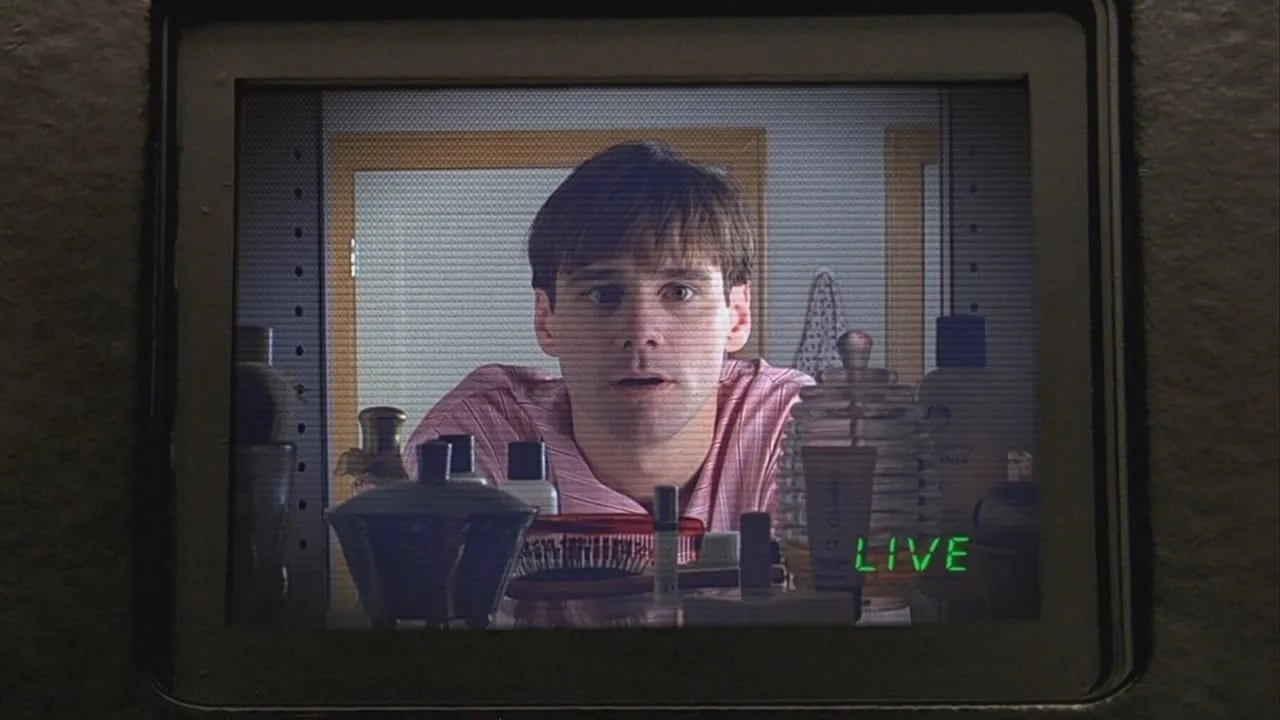
This is Your Life: The Truman Show
Director Peter Weir and cinematographer Peter Biziou, BSC tell the imaginative tale of a hapless man whose very existence has been turned into a television show.
Photography by Melinda Sue Gordon, SMPSP and Peter Biziou, BSC
This article was originally published in AC, June 1998. Some images are additional or alternate.
In today’s media-saturated world, cohabitating strangers are ceaselessly documented in vivid detail on MTV, continuous video feeds from the bedrooms of young women are available to anyone with Internet access, and an unending stream of people seem willing to reveal sordid aspects of their lives on tabloid television talk shows.
This alarming set of real-life circumstances has inspired accomplished director Peter Weir (Witness, Dead Poet’s Society) to “broadcast” The Truman Show, an endlessly inventive feature film about a man whose entire life, 24 hours a day since birth, has been televised to the world without his knowledge.
The unwitting star of this wildly popular program, Truman Burbank (Jim Carrey), is selected from a group of unwanted children by producer Christof (Ed Harris), a domineering auteur who hires actors to portray young Truman’s parents, friends, co-workers and, eventually, his wife.
Truman is raised in an island town painstakingly assembled on the world’s largest soundstage — an enclosed, county-sized, and completely artificial bubble with its own fake sun, sky and weather. Unable to overcome his crippling fear of water (a condition produced during his youth when a boating mishap claims the life of his “father”), Truman is a prisoner of his surroundings, but eventually adjusts to — and even revels in — the town’s relentlessly cheery environment. His every move is recorded by 5,000 hidden television cameras which are manipulated from Christof’s central control room, located high above it all in a bogus “moon.” The effort is all worth it, because The Truman Show is a worldwide smash that earns a tremendous fortune for its creators.
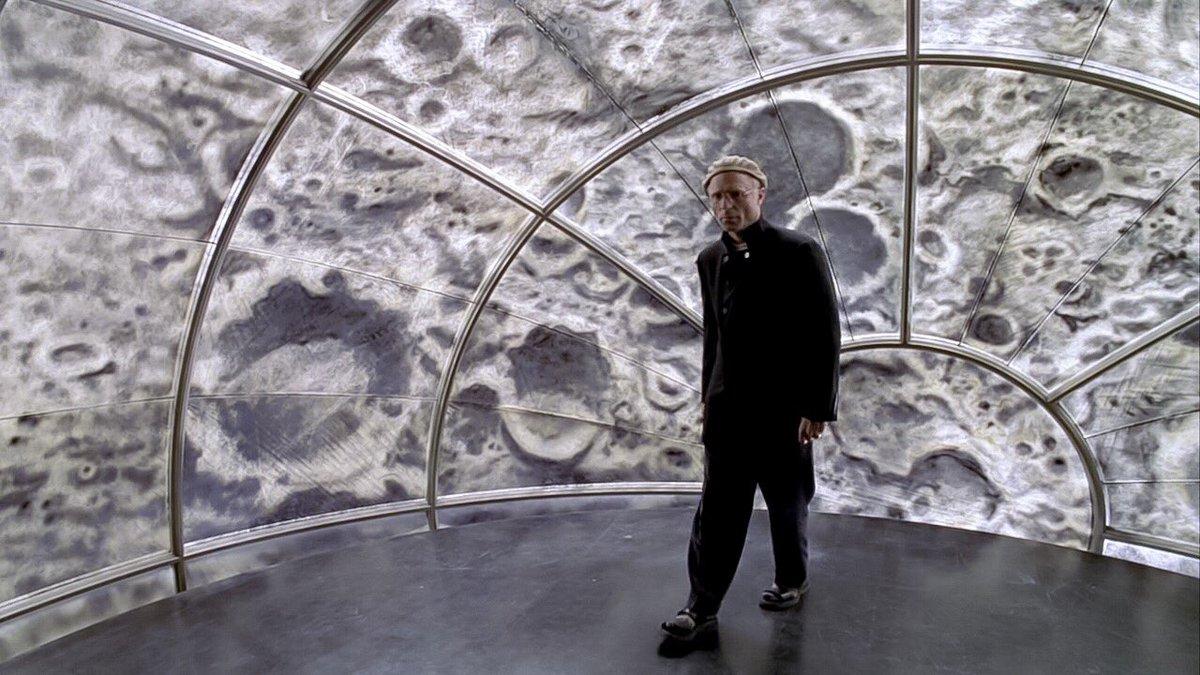
However, the oblivious Truman is not completely untouched by reality. As a youth, he becomes smitten with Sylvia (Natascha McElhone), a young female “extra” with a forthright manner and strong, unusual good looks. During a stolen nighttime rendezvous at the beach, she begins to tell him the big secret, only to be cut off by her “father,” who zooms right up to the shoreline in the family automobile. Stuffing his daughter into the front seat and slamming the car into gear, the man shouts out that the clan is moving to Fiji.
Truman is so haunted by this brush with real-life infatuation, and so uninterested in his bland “Stepford Wife” spouse, Meryl (Laura Linney), that he begins a touching daily ritual: purchasing fashion magazines and using the photographs in them to try to piece together a simulacrum of the absent Sylvia’s face, police Identikit-style. When not trying to re-create Sylvia’s haunting beauty, Truman unsuccessfully attempts to contact the island of Fiji. He soon begins to discover other chinks in Christof’s artificial world, but his attempts at escape are invariably foiled in setpieces reminiscent of the surrealistic Sixties television show The Prisoner. Weir says that he was attracted to this unusual project because of the quality of the screenplay, which was penned by fellow director Andrew Niccol (Gattaca). The esteemed Australian filmmaker explains, “I was intrigued by this complete world that Andrew had invented, because I knew that I would be involved in creating everything from the ground up, a world within a world.”

To assist in the building of the story’s bright, clean fantasyland, Weir chose director of photography Peter Biziou, BSC, whose resume includes such stunningly photographed films as Richard III, In the Name of the Father and Mississippi Burning (for which he earned an Academy Award for Best Cinematography). “I was taken with the way Peter uses light, his choice of lenses and his overall look,” the filmmaker says. “I loved his work with [directors] Alan Parker and Jim Sheridan. He takes chances, yet one always sees what one needs to see. I also knew that Peter is selective and only takes on films to which he feels he can offer something unique.”
Weir further sensed that Biziou “was a man you could talk to, and he had a great interest in light and how it fell in relation to the story. The way the light falls in our images is a major part of a director's storytelling ability, followed only by dialogue. Here was a case where a hell of a lot of the film’s story had to be told with the light.
“We were after a heightened reality, an artificiality, and we needed to devise a way to convey that feeling without it being too disturbing to the audience. If it looked too odd, then the audience might feel that Truman should have caught on to [his situation] sooner.”
— director Peter Weir
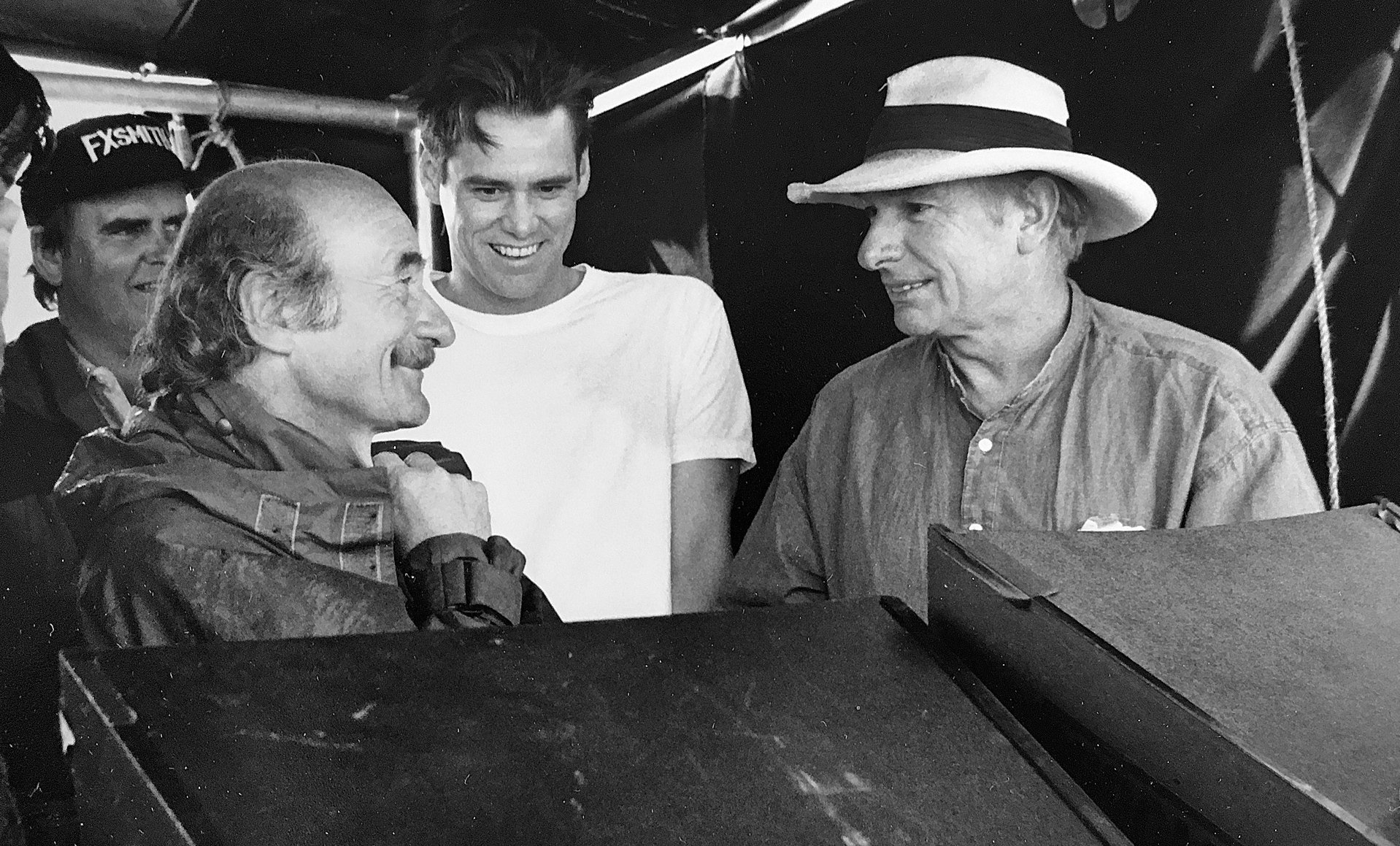
“All of the light in Truman’s world is artificial,” Weir continues. “We were after a heightened reality, an artificiality, and we needed to devise a way to convey that feeling without it being too disturbing to the audience. If it looked too odd, then the audience might feel that Truman should have caught on to [his situation] sooner. It had to look, at least at the start, like a somewhat regular movie; we have to believe it as much as Truman believes it. Then we can allow it all to come apart.” The result of this thinking was Biziou’s masterful use of a high-key lighting style which is the polar opposite of film noir, yet somehow achieves a similarly eerie emotional resonance.
In searching for the right look, Weir also studied old Saturday Evening Post covers by hyper-realist painter Norman Rockwell. He found inspiration in the “idealization” of Rockwell’s renderings of an America that had already largely vanished by the time the artist created many of them.
Along with production designer Dennis Gassner (Waterworld, The Hudsucker Proxy) Weir and Biziou even researched the field of covert video surveillance. It was determined that while the various lenses and systems used in that field created an effective look, “most of them were too strong and obvious for us,” Biziou explains. “Peter wanted us to use the simplest methods to imply surveillance so that he would be free to be as dramatic as he wished in telling the story.”
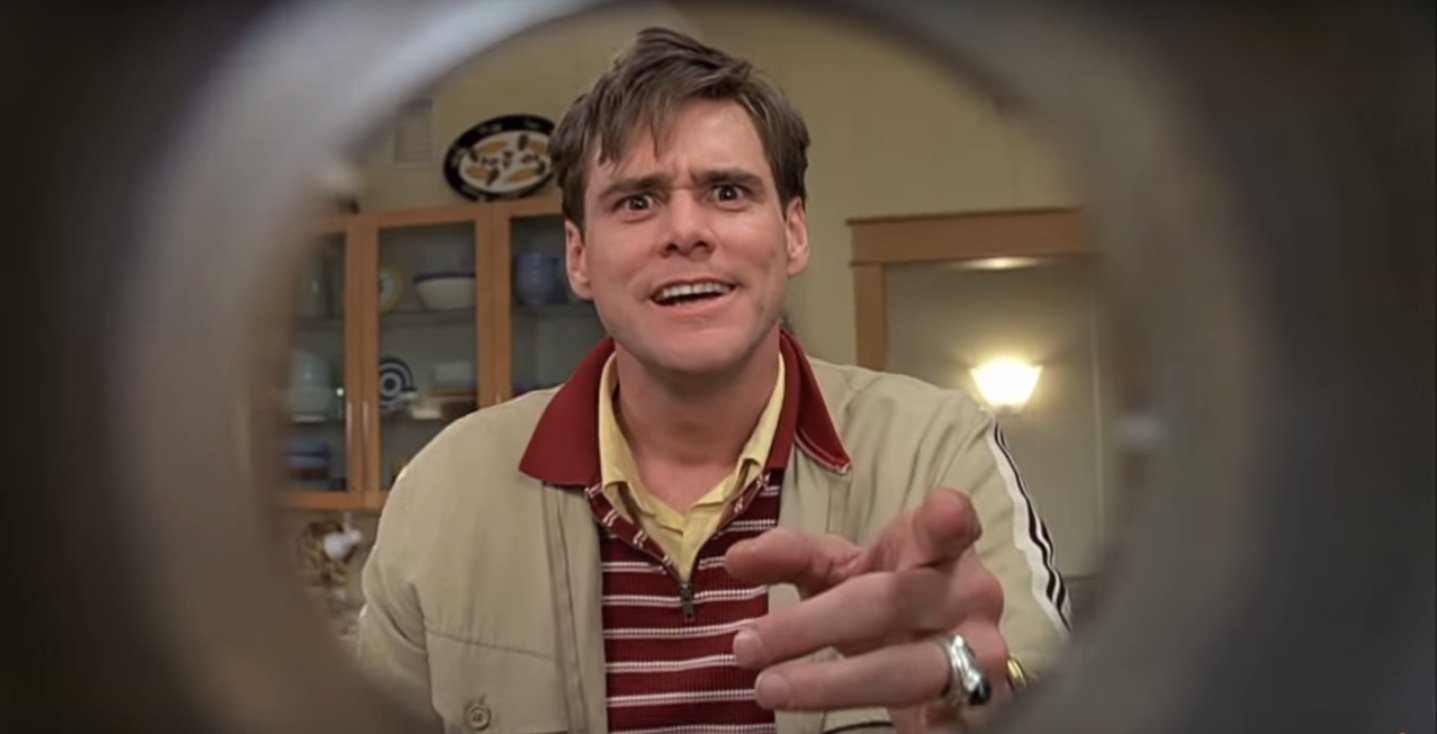
To suggest the “surveillance” feel, Biziou used “slightly unusual camera angles and positions, and framing foreground elements in a stronger way, which seemed to support the uneasy feeling” that was inherent in the story.
Weir saw The Truman Show as a chance to utilize the long-abandoned silent-era cinematic technique of vignetting the edges of the frame to emphasize the center. He used this technique to suggest that the cameras watching Truman were indeed hidden behind or contained within various objects. He offers, “I had become hooked on vignettes, as used by people like D.W. Griffith. I love the technique purely on its own, as a simple but highly effective cinematic device. It was somewhat surprising to me that vignetting hadn’t yet been revived.”
To create the vignettes, which Biziou says also helped convey “a more obvious, menacing feel,” the cinematographer used a variety of gobos placed in front of the lens. Some of the effect was also added or enhanced digitally by postproduction supervisor Mike McAlister, whom Biziou credits with “doing a great deal to subtly enhance the look of the film.”
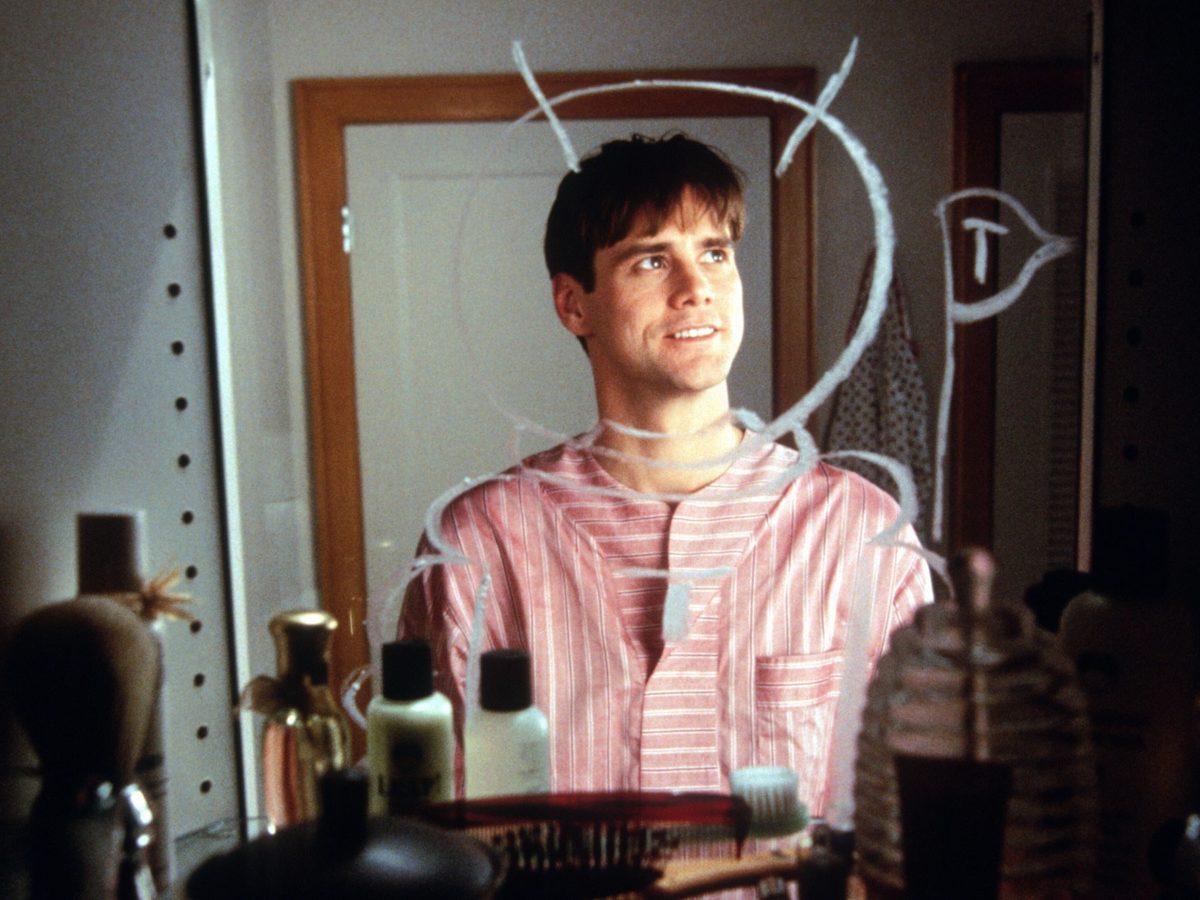
Naturally, the overall look of The Truman Show was influenced by television images, particularly commercials. Weir offers, “We took a lot from the current vogue for extreme wide-angle lenses in commercials, where characters often lean into the lens with their eyeballs wide open. And we borrowed our high-key, somewhat glossy lighting approach from commercials and situation comedies. We often used a lot more light in interiors than one would normally use, to keep it all sparkly and clean. We were always reminding ourselves that in this world, everything was for sale.” The director specifically refers to the story’s winking conceit that the fictional Truman Show series is supported entirely by advertising revenue generated by in-your-face product placements staged by Truman’s friends and associates.
Other influences also shaped the look of the film. Weir notes, “We began to adopt a combination of imaging styles from the bold graphic framing of television commercials to the more obvious, somewhat menacing feeling of surveillance, using static, long-held angles. We combined these with the predictable visual routine of TV soap operas.” Subtlety ruled the day, however: “The public is so aware of what is going on with TV that we only had to infer these various feelings.”

While interiors showing Truman’s domestic life were filmed in a way that was “a little too well-lit and sort of glossy,” Biziou didn’t want the lighting to be overly brash. Seeking to retain some of the filmic quality that is expected in features, the cameraman says that he modified the television-style lighting by sculpting it with “a lot of black flagging and drapes, to control the soft light and keep it from being too flat.”
Truman’s world was created by the filmmakers in the real-life municipality of Seaside, Florida, a “planned community” created by developers on 78 acres of beachfront property on the Gulf Coast. The real town of Seaside (called Seahaven in the film) was designed so it would maintain a distinctly Rockwell-esque look, recalling small-town, pre-suburban America. (According to a report in The New York Times, all Seaside homes are required to have a front porch and a white picket fence.)
Needless to say, Seaside was chosen for its slightly unreal, too-perfect look. For Biziou’s purposes, however, the town was far from perfect. As he details, “Seaside consists of rows and rows of similar houses, all of which were white or pale pastel, and it faces south. That [color scheme], bathed in strong, glistening sunlight all day long, naturally created extremes of contrast and shadows. It was only by putting in a tremendous amount of fill light that we achieved the quality that really suited our needs.
“It began to take on this very slightly super-real feel, almost looking like a controlled environment, which was exactly what we were after.”
— Peter Biziou, BSC
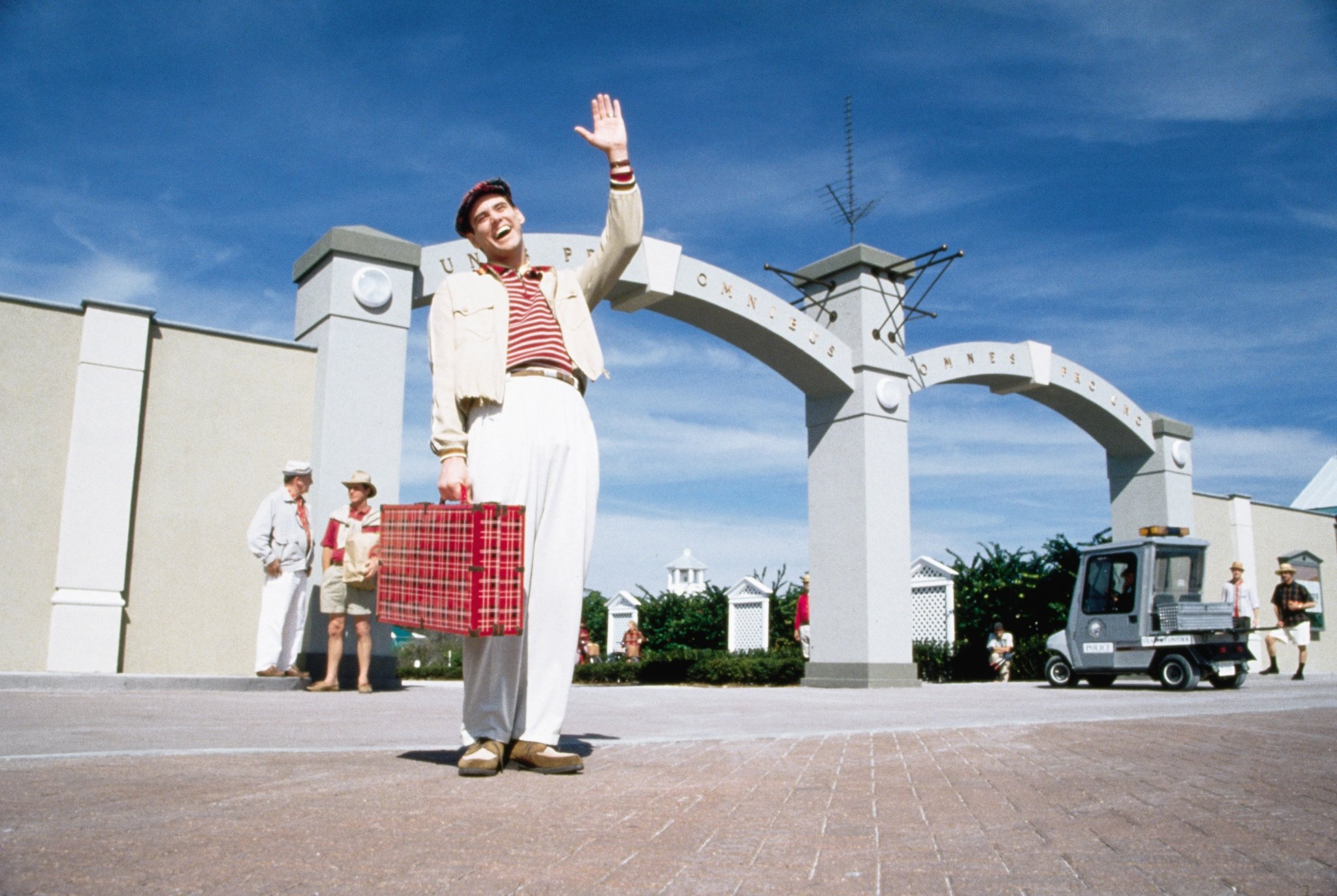
“In adding the fill, we got this lovely bright sunny feel without any craggy harsh shadows anywhere,” Biziou elaborates. “It began to take on this very slightly super-real feel, almost looking like a controlled environment, which was exactly what we were after. It is often by accident, perseverance and accepting what you’ve been given that you do things you never quite expected.
“This huge amount of fill also gave us very good apertures — f8 or f11 on daylight exteriors — and the depth and sharpness added to the hyper-realistic feel.”
Producing such an abundance of bright daylight fill was a major technical undertaking. “We used enormous 40'-square scrim reflectors and diffusers, several of them at a time, which could be moved into place quickly via cherry pickers,” Biziou recounts. “We would aim several 12Ks at or through these scrims, which would produce volumes of lovely, powerful, soft fill. Combined with the bright blue skies, this look helped imply that there was something unreal going on, but one never knew quite what.”
Weir concurs with his cinematographer, noting that the augmented Florida light was as important to the look and feel of the film as the town itself. “When we got a clear day, the sky was a sort of aching blue and the houses were gleaming white,” the director recalls. “Waiting for clear, windless days and then pumping in all of this fill slowed us down, but I would remind myself when I was getting impatient that this was being done in order to make everything gleam and look like a commercial.”
“The story of The Truman Show is not new; it is a love story about a man trying to reach freedom and find the truth.”
— director Peter Weir
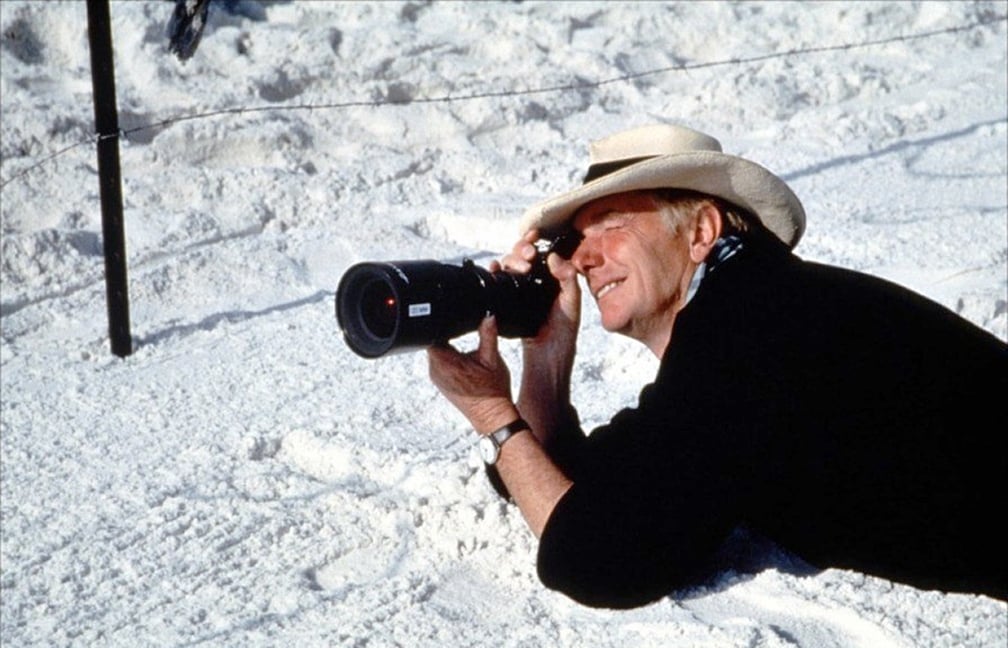
“I think when Peter took his first look at the town, he gulped hard,” Weir adds. “You had to wear sunglasses just to look at the houses. But I am thrilled with his work.”
To help cope with the extremes of contrast still evident in the day exterior setups despite the enormous fill lights, Biziou chose to shoot these portions of The Truman Show on Eastman Kodak’s EXR 5248 stock, which is rated at 64 ASA for daylight with an 85 filter. “We used it for its fine detail and excellent exposure latitude,” he says. “It was wonderful for handling the extremes in contrast that we weren’t quite able to tame.”

For day interiors and car shots, Biziou used Kodak’s 200 ASA EXR 5293. “I wanted good aperture and depth,” he offers. “For night interiors and exteriors, I used the 500 ASA [Vision 500T] 5279, which is a great high-speed stock with surprising sharpness and detail.”
Throughout the show, the cinematographer worked closely with Deluxe Laboratories, which “gave us consistently good dailies, for which I was really grateful.” However, Biziou did extra work to help ensure that his dailies hit the mark. “In addition to the normal lab reports, I sent Deluxe handwritten notes on each day’s run, so the timer would be well-informed,” he relates. “They said they found these notes useful, as they normally get no such information and don’t have any guidance on how to print. Mike Millican, the timer at Deluxe who finished the film, gave us a wonderfully-timed first print.”

In order to keep the images clear and sharp, Biziou avoided lens diffusion and filtration during initial photography. He reveals, however, that “we did ask for a slight warm tone on the final grading before the release print. We found this tone in one of our daily runs and just loved the way it looked.”
Biziou’s camera system was a new choice for him: Panavision’s Platinum Panaflex with Primo lenses, which “hold [strong light] before flaring very well and take contrast very kindly. I tested them extensively because I had never used them before. This film was an ideal place to use the Primos because of the wide contrast ranges we encountered in the bright sun.”
Wide-angle lenses were used extensively to both emulate the style of television commercials and to approximate the super-wide look of the extreme lenses used on surveillance cameras. Aspheron elements were sometimes added to the wide lenses to make them even wider and further emphasize the off-kilter feel of life in Seahaven. Long lenses were also used to mimic images created by stationary outdoor surveillance cameras, such as those now so popular with television news operations.
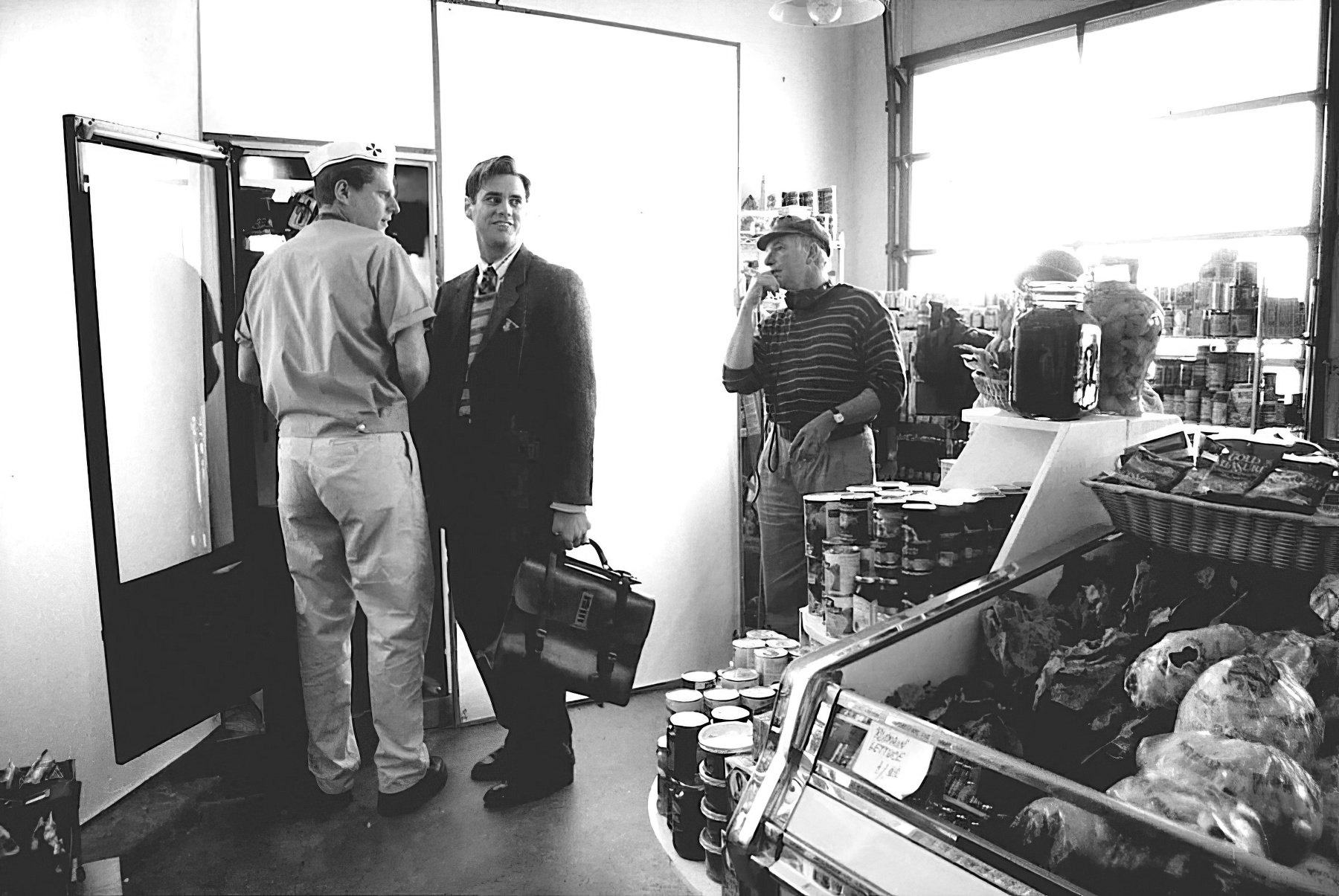
In a town with 5,000 hidden cameras, the devices are bound to show up in some unusual places, and Biziou credits his crew with bringing that concept to life. “Our key grip, Chris Centrella, is one of the most imaginative I’ve ever worked with,” the cinematographer attests. “He would put cameras in the most extraordinary places on short notice. If suddenly we wanted to put a camera in the revolving doors of Truman’s office building, Chris would have that ready for us while we were shooting another scene. He was always ahead, always asking bright questions and on his tip-toes all the time, but with a smile!”
Biziou notes that Centrella played a hand in creating one of the more amusing and unexpected shots in the film, in which Truman is seen driving his car from a very unusual perspective. The cinematographer explains, “We were using a car that had been stripped of the dashboard and engine to allow us flexibility in camera placement, so we got a wide-angle lens right in there where the dashboard radio would have been, and added a masking gobo in front of the lens. Mike McAlister later composited in some little liquid-crystal digital numbers to reveal that we were in fact looking at Truman from the inside of his car radio.”
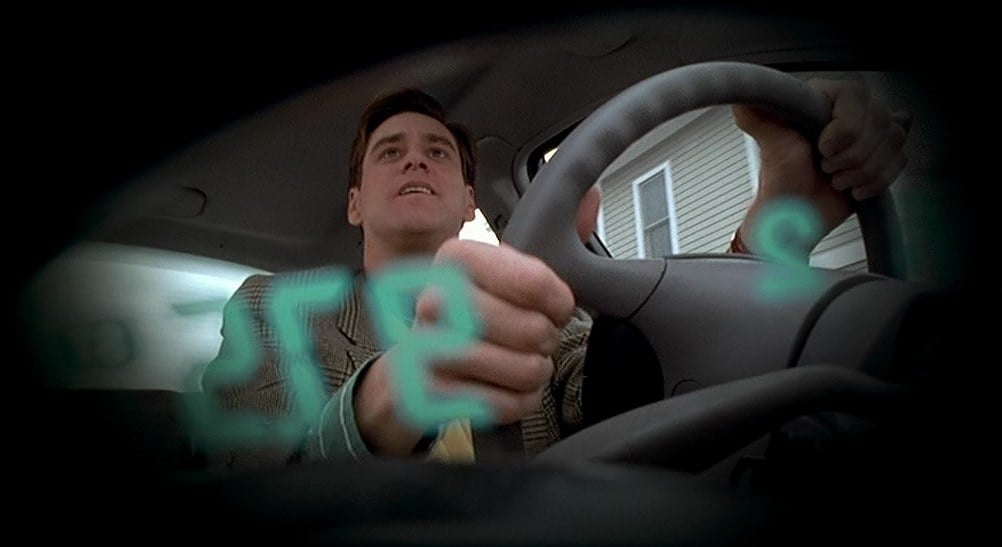
This scene, like all of the driving shots, was lit with bright diffused light. Biziou reports, “We went to the extra effort of balancing the light levels in the car interiors to the outside so that we would have the same exposure level for both, to get the look of a controlled environment, and the depth of field to heighten it.”
The lenses used for the car interiors were some of the widest on the show, including 12mm, 14mm, 17mm and 21mm units. Biziou reports that these extreme optics were occasionally pushed even further with the addition of diopters, which allowed the lenses to be placed even closer to the subject than normal to “add to the uneasy feeling we were after.”
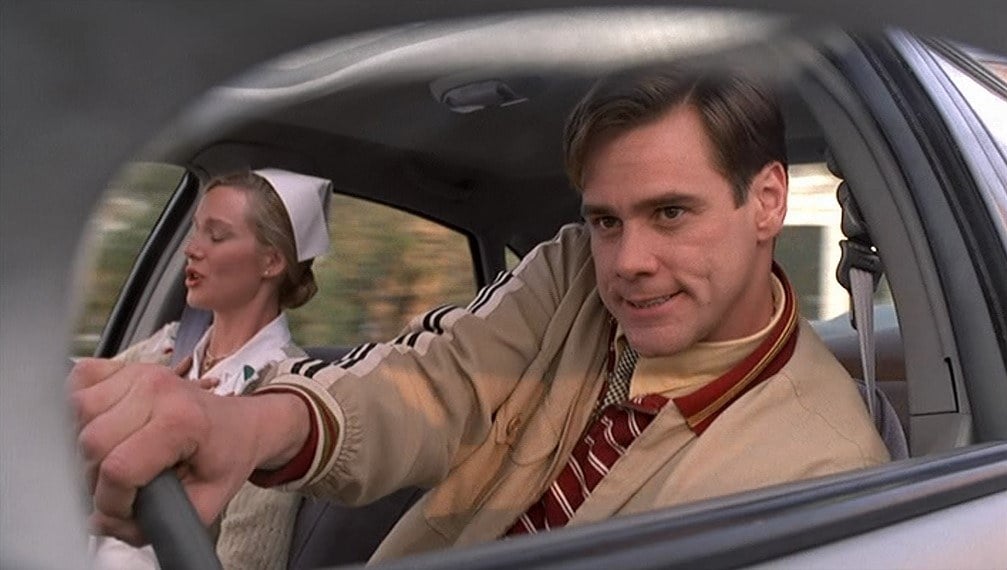
While Seahaven has the look of a normal, albeit idealized town (occasionally recalling the idyllic suburbs depicted in such television shows as The Brady Bunch), its complete artifice leads to some odd occurrences in the film. One hilarious example is an early scene in which an HMI lamp falls from the sky and crashes to the ground next to Truman, prompting him to search the heavens in utter confusion. Adding to the gag is the fact that the lamp is labeled “SIRIUS” — denoting it as Alpha Canis Majoris, the Dog Star, and the brightest in the sky after the sun. Biziou recalls, “It was in the script that some object fell from the sky, and the question of just what it should be was going around the set. Peter Weir took great pleasure in asking people what they thought the object should be, and then took great pleasure in deciding that it should be a movie light. We did two shots the lamp falling, but Peter later decided he wanted a high, aerial view, which Mike McAlister put together on the computer using a high-angle shot of the town.”
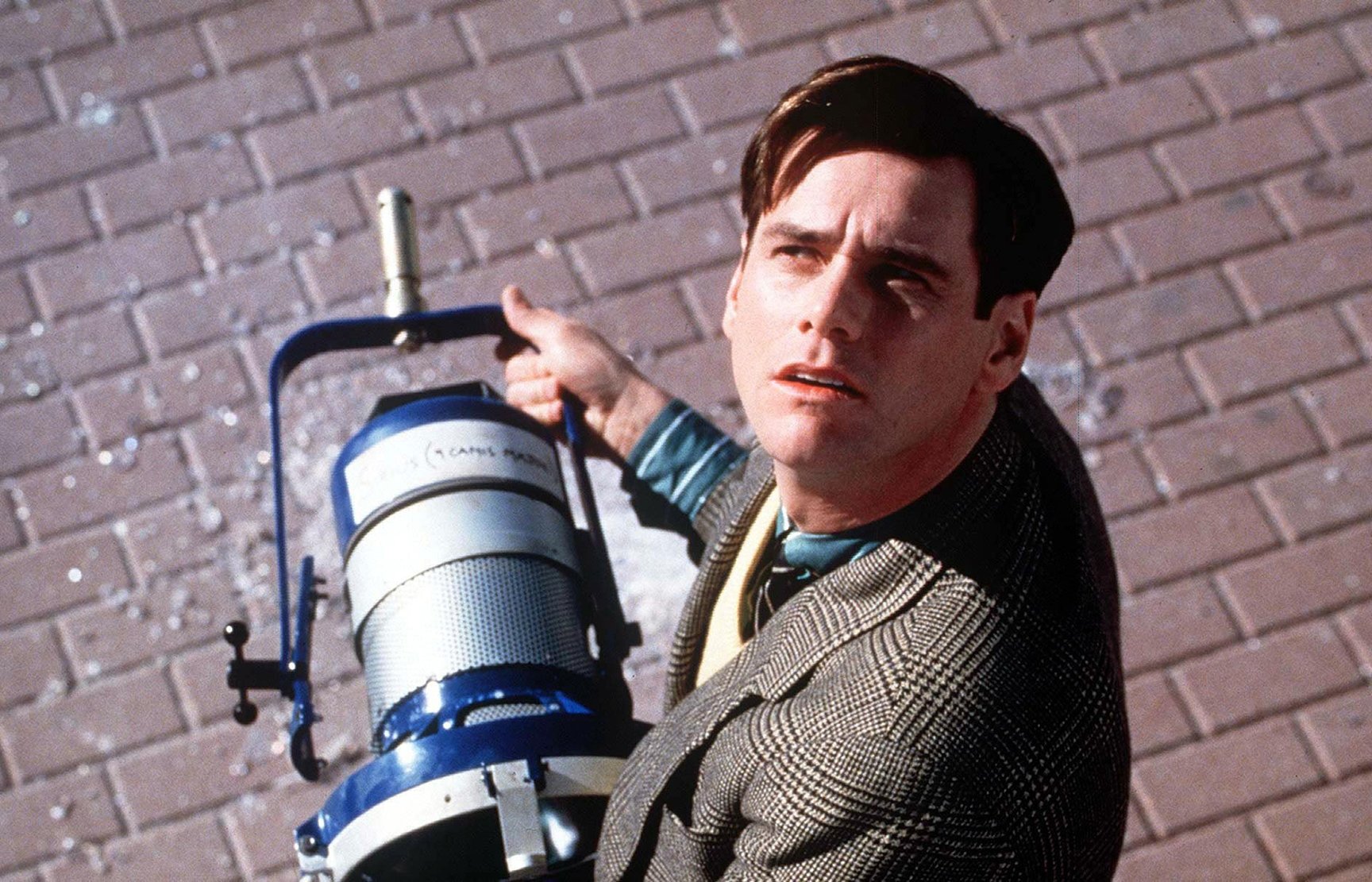
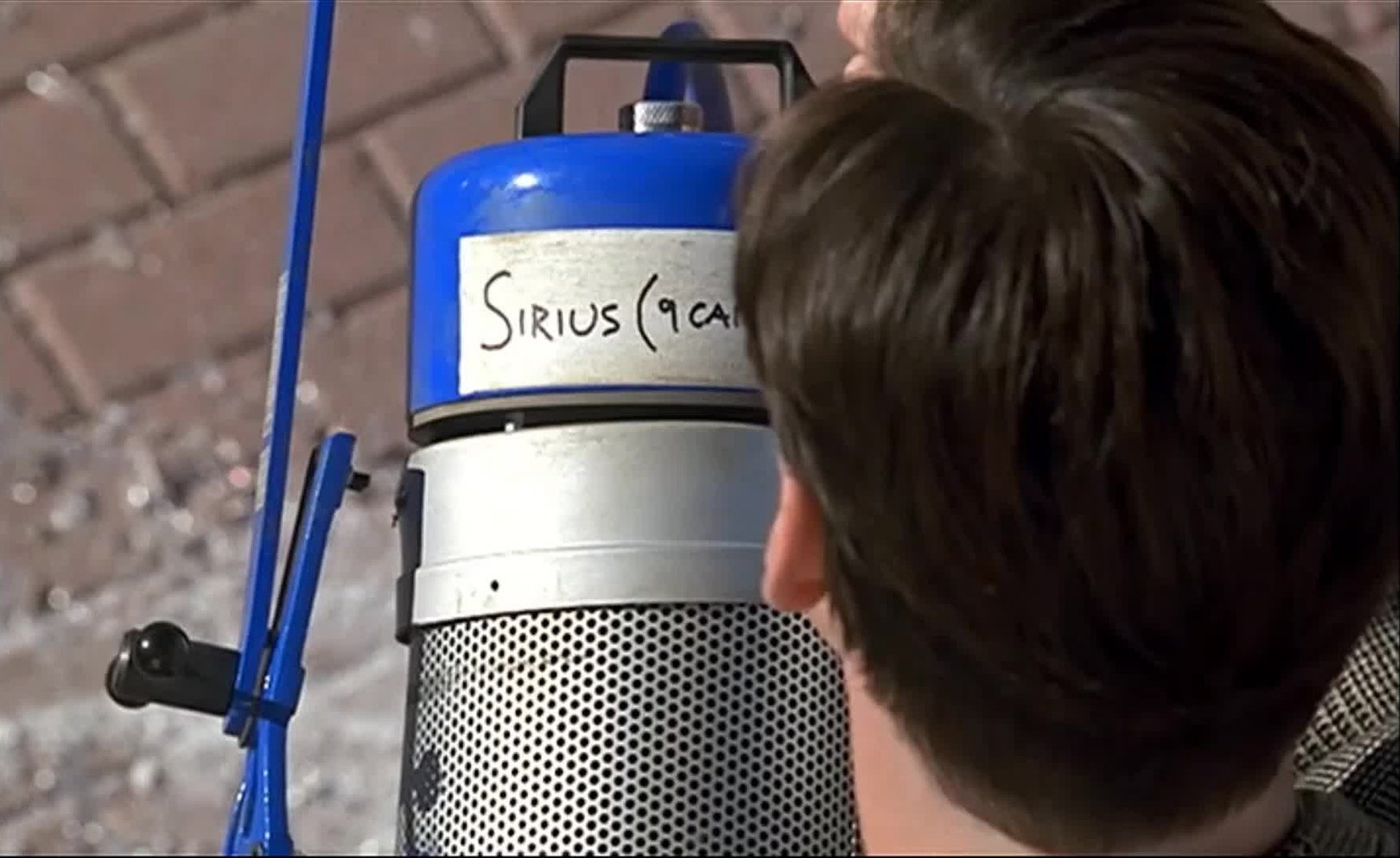
Another combination of in-camera and digital work occurs during a frantic nighttime search for Truman after he somehow eludes the ubiquitous cameras and disappears. Christof tells his staff to bring up the sun, even though it is still nighttime by the show’s internal clock. Reports Biziou, “We actually brought up the sun — physically. Our key grip and the chief electrician mounted about 300 Par 36 bulbs into three large banks mounted on a tube frame on a crane hoist. We then jerked these lights up 60' in the air in about four seconds.”
The dramatic lighting plan was heightened by the use of a false horizon. Biziou continues, “We had an enormous black flag stretched between two cherry pickers just in front of the lights when we popped them into the air. The shadows of the people and the trees shortened quickly, and the horizon line washed across the buildings. It was quite an effect, and it worked well in combination with Mike McAlister’s amazing impressionistic digital sunrise.”

While the God’s-eye view of the HMI dropping from the sky and the shot of the rapidly rising sun are overt uses of special effects, Biziou believes that many of the film’s other postproduction enhancements will sneak past almost everyone. “Mike McAlister digitally added a little fill and diffusion in the last seconds of the shots depicting the effects of the rapid sunrise, just to help the fake sunlight look more like daylight,” the cameraman begins. “But a lot of the other digital elements look photographic as well. At times, the weather would change and we’d lose the intense blue skies we felt were so important. Mike would put them back digitally. I love it when digital work is subtle and is used without doing bangs and crashes and explosions.” Additional extensive “invisible” effects work was added by Matte World Digital, including the creation of Seahaven’s false topography, the extension of various buildings' exteriors, and the addition of scope to the surrounding artificial sea and sky.
The ruse of Truman’s life in Seahaven, of course, eventually fails. When our hero finally realizes that something is terribly wrong and that he is unable to leave the town by any land routes, he confronts his aversion to the water by heading out to sea on a sailboat. Biziou recalls, “[After finishing in Florida,] we rushed back to Los Angeles and set up at the Universal Studios tank, where Peter Chesney had built special water dumps, wave-makers and hydraulic lifts so we could put the boat on its side or turn it completely over.”
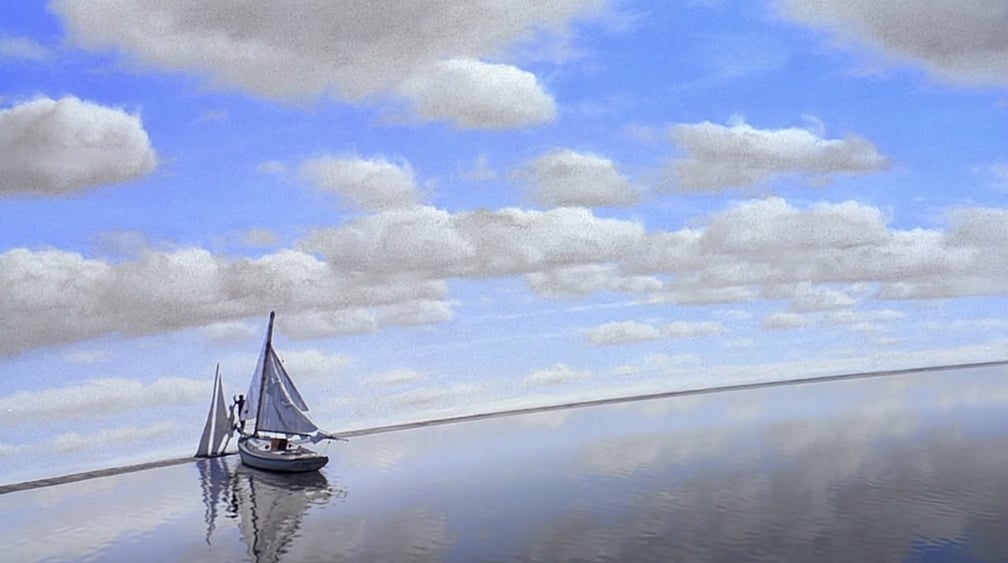
All of the sailing action takes place over a short period of time in the story, so Biziou needed to have consistent lighting throughout the two-week tank shoot. Toward this end, he explains, “Chris Centrella built a 100' by 60' diffusion scrim and got the largest mobile crane possible, which could go 250' up. Chris would literally boom this flag over the tank to keep Truman’s boat in shadow. As the sun moved from east to west, he would move the flag so we always stayed in shadow. It was a real bonus that gave us immediate lighting consistency.”
However, Biziou cautions that this bold approach was not without considerable risks. “Chris had to compute and work out his stresses and strains and really know what he was dealing with, because any wind over 15 miles an hour could have tipped the crane over. You could lift an airplane with that kind of span. Fortunately, we had no such problems.
“The big scrim gave me the soft light of an overcast day, so I then armed in a Musco from the background to add a strong backlight source to all of the various waterworks, such as the rain and waves. Water spurts just have no life without some backlight. The diffused sunlight and the Musco backlight comprised the only lighting we used in the scene.
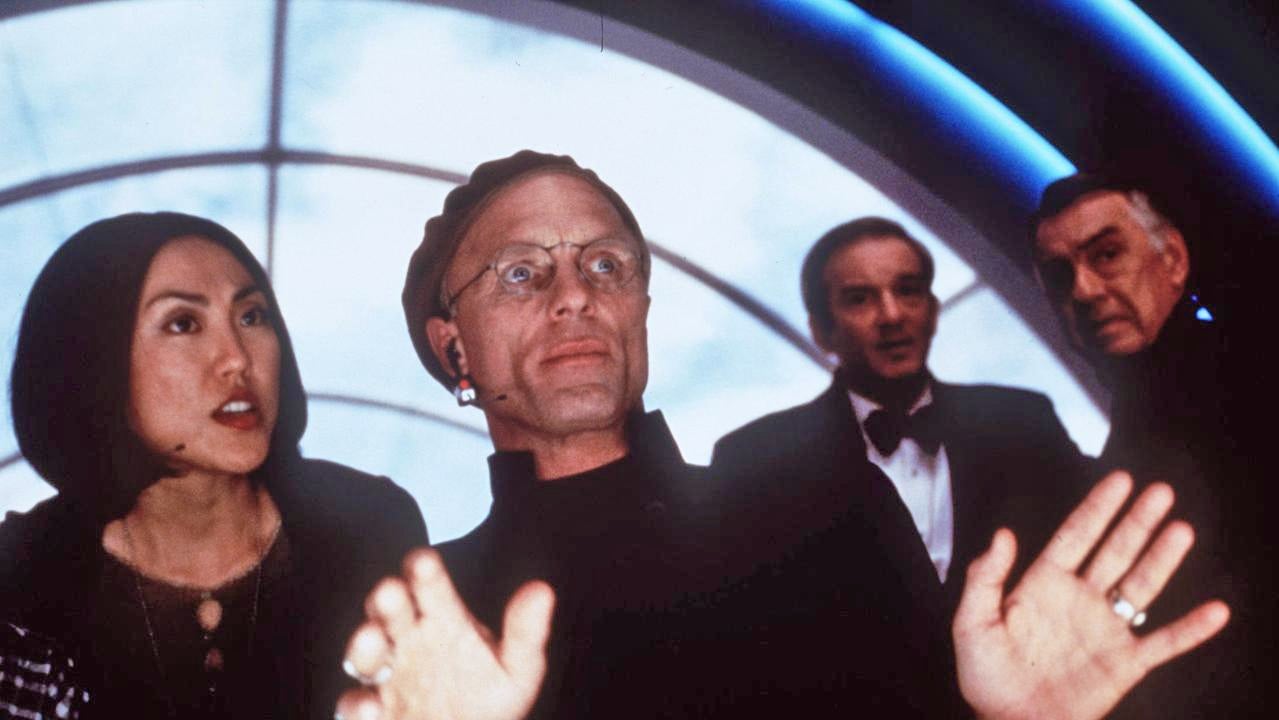
In an attempt to get the water-shy Truman to turn the boat back toward shore, Christof orders up some nasty weather, escalating the tumult as the undaunted star soldiers forward. Finally, horrendous hurricane-force winds are dialed up from the Truman Show control room. To create the tempest, Biziou explains, “we had two jet engines on trucks, as is common these days, which screamed across the water and just took the tops of the waves off and gave them a nice cresting. These engines are extremely noisy and smelly, but I’d recommend them any time; they’re wonderful machines. It was a joy to see a proper thrusting wind. That, coupled with the blasting of fire hoses into the jet engine stream, which would just get energetically strewn across the whole scene, gave us some wonderful storm footage.”
The defiant Truman eventually ties himself to the boat’s mast, willing to die in his attempt to discover what is beyond the manmade confines of Seahaven. Picking up on that classical element, Weir notes, “The story of The Truman Show is not new; it is a love story about a man trying to reach freedom and find the truth.
“What is new is the state that we find ourselves in during the late 20th Century. With the colonization of the airwaves, with empires being formed by satellites beaming programs down and by the Internet, there are now more people with enormous power and influence in our lives — people who are not elected to these positions. And while they’re not necessarily malevolent people, we know how power corrupts. It will be interesting to see how people respond to a story that deals with someone who is misusing that power, someone who is not in the guise of a conventional villain.”
Paramount Home Entertainment has scheduled a new 25th anniversary 4K Ultra HD Blu-ray release of The Truman Show for July 4, 2023.
If you enjoy archival and retrospective articles on classic and influential films, you'll find more AC historical coverage here.






